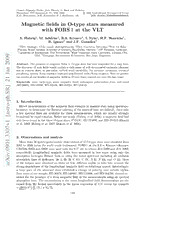Table Of ContentCosmic Magnetic Fields: from Planets, to Starsand Galaxies
Proceedings IAU Symposium No. 259, 2008 (cid:13)c 2008International AstronomicalUnion
K.G. Strassmeier, A.G. Kosovichev & J. Beckmann, eds. DOI:00.0000/X000000000000000X
Magnetic fields in O-type stars measured
with FORS 1 at the VLT
S. Hubrig1, M. Sch¨oller2, R.S. Schnerr3, I. Ilyin4, H.F. Henrichs5,
R. Ignace6 and J.F. Gonz´alez7
1ESO, Santiago, Chile; email: [email protected]; 2ESO,Garching, Germany; 3Inst. for Solar
Physics, Royal Swedish Academy of Sciences, Stockholm,Sweden: 4AIPPotsdam, Germany;
5University of Amsterdam, The Netherlands 6East Tennessee StateUniversity,Johnson City,
9 USA;7Complejo Astronomico El Leoncito, San Juan, Argentina
0
0
2 Abstract. The presence of magnetic fields in O-typestars has been suspected for a long time.
n Thediscovery ofsuchfieldswould explainawiderangeofwell documentedenigmatic phenom-
a ena in massive stars, in particular cyclical wind variability, Hα emission variations, chemical
J peculiarity,narrowX-rayemissionlinesandnon-thermalradio/X-rayemission.Herewepresent
1 theresults of our studiesof magnetic fields in O-typestars, carried out overthelast years.
2
Keywords. stars: early-type, stars: magnetic fields, techniques: polarimetric,stars: individual
] (HD36879, HD148937, HD152408, HD164794, HD191612)
R
S
.
h
p
1. Introduction
-
o
Direct measurements of the magnetic field strength in massive stars using spectropo-
r
t larimetry to determine the Zeeman splitting of the spectral lines are difficult, since only
s
a a few spectral lines are available for these measurements, which are usually strongly
[ broadenedbyrapidrotation.Beforeourstudy (Hubriget al. 2008),amagnetic fieldhad
1 only been found in the three O-type stars,θ1OriC, HD155806,and HD191612(Donati
v et al. 2002; Hubrig et al. 2007; Donati et al. 2006).
7
0
3
3
2. Observations and analysis
.
1
More than 50 spectropolarimetric observations of 15 O-type stars were obtained from
0
9 2005 to 2008 using the multi-mode instrument FORS1 at the 8.2-m Kueyen telescope.
′′
0 GRISMs 600B and 600Rwere used with the 0.4 slit to obtain R≈2000and R≈3000,
: respectively. Longitudinal magnetic fields were measured in two ways: using only the
v
i absorption hydrogen Balmer lines or using the entire spectrum including all available
X
absorption lines of hydrogen, He I, He II, C III, C IV, N II, N III, and O III. Most
r of the targets were observed on three or four different nights to take into account the
a
strong dependence of the longitudinal magnetic field on rotational aspect. Interestingly,
a large part of the observed stars exhibited a change of polarity over certain nights.
Four stars ofour sample,HD36879,HD148937,HD152408,and HD164794,showedev-
idence for the presence of a weak magnetic field in the measurements using all spectral
absorption lines. The uncertainties in the mean longitudinal field determination are ob-
tained from the formal uncertainty in the linear regression of V/I versus the quantity
−4πgmeffeec2λ2I1ddλI hBzi+V0/I0.
119
120 S. Hubrig et al.
ux 00..2350
d fl
e 0.20
aliz
orm 0.15
N
V/I 00..0150
0x 0.00
1
-0.05
5012 5013 5014 5015 5016 5017 5018 5019 5020 5021
Heliocentric wavelength (Angstrem)
Figure 1. Low signal-to-noise Stokes I and V spectra of HD191612 obtained with the echelle
spectrographSOFIN.Duetotheratherfastrotationofthestarthecontributionofblendsisnot
easily recognizable in theStokesI spectrum. Ontheother hand,theblendsbecome detectable
intheStokesV spectrumduetotheZeemansignaturesproducedinmagneticallysensitivelines.
3. Discussion
This is the first time that magnetic field strengths were determined for such a large
sample of stars, with an accuracy comparable to the errors obtained for the three previ-
ously known magnetic O-type stars, θ1OriC, HD155806, and HD191612.For the mag-
netic Of?p star HD191612, Donati et al. (2006) measured a magnetic field of hBzi =
−220±38G, by averaginga total of 52 exposures obtained over 4 different nights. This
is similar to our typical errors of a few tens of G. The new high-resolution observa-
tions (R ≈ 30000) of the O7 V(n) star HD36879 and the O8fpe star HD191612 with
the SOFIN echelle spectrograph mounted at the 2.56m Nordic Optical Telescope indi-
cate the presence of weak magnetic fields of positive polarity in both stars. In spite of a
ratherlowsignal-to-noiseratioachievedintheseobservations(S/N≈200–270),causedby
bad weather conditions, it was still possible to detect Zeeman features at the positions
of He II, C IV, O II, and N III lines. An example of our observation of HD191612 is
presented in Fig.1.
The four new magnetic O-type stars have different spectral types, luminosity classes,
and behavior in various observational domains. The study of the evolutionary state of
one of the Galactic Of?p stars, HD191612,indicates that it is significantly evolvedwith
an ∼O8 giant-like classification (Howarth et al. 2007). The youth of the most carefully
studied magnetic O-type star θ1OriC and the older age of the Of?p star HD191612
suggest that the presence of magnetic fields in O-type stars is unrelated to their evolu-
tionary state. We note that it is unclear yet whether more complex, smaller scale fields
play a role in the atmospheresof hot stars.In the case ofa more complex magnetic field
topology, the longitudinal magnetic field integrated over the visible stellar surface will
be smaller (or will even cancel) and will not be easily detected with the low-resolution
FORS1 measurements. However, high resolution spectropolarimeters (like ESPaDOnS,
Narval, or SOFIN) should be able to detect such complex fields.
References
Donati, J.-F., Babel, J., Harries, T. J., et al. 2002, MNRAS, 333, 55
Donati, J.-F., Howarth, I. D., Bouret, J.-C., et al. 2006, MNRAS,365, L6
Howarth, I. D., Walborn, N.R., Lennon,D. J., et al. 2007, MNRAS,381, 433
Hubrig,S., Yudin,R.V., Pogodin, M., et al. 2007, AN,328, 1133
Hubrig,S., Sch¨oller, M., Schnerr,R.S., et al. 2008, A&A,490, 793

